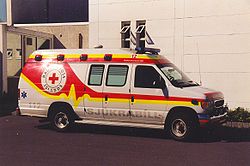Organization
Land ambulance
There are currently approximately 77 operational land ambulances in Iceland. These are distributed across almost all communities, usually at fire stations. They are owned and equipped by the Icelandic Red Cross, but are crewed by fire service personnel. In larger centres, such as Reykjavík, the ambulances are staffed by full-time, paid Emergency medical technicians. In smaller centres, EMTs may be part-time, or even on-call from home in some cases. All ambulance personnel are either the equivalent of EMT-B or EMT-I. Staffing of ambulances is normally 2 people, with two EMT-Bs, or, where available, an EMT-B and an EMT-I. [4] Paramedics are usually found only in Reykjavík, which operates a single, Advanced Life Support ambulance with a crew of three. Ambulances are organized according to the country's multiple Health Service Districts, but are centrally dispatched. At 2014, the ambulances were converted Mercedes vans.
- Land Ambulance in Iceland
- Reykjavík
- All service provided by Red Cross
- Rural Ambulance/Rescue Vehicle
Air ambulance

Because of the sparse population, bad weather, and large numbers of airports, most air ambulance service in Iceland is accomplished using fixed-wing aircraft. The government of Iceland has contracted out this service since 2001. [5] The type of aircraft normally used is a Beechcraft Super King Air 200 operated by the airline Mýflug (Myflug Air). Mýflug has one dedicated air ambulance in Iceland, based at Akureyri, the site of the country's second largest hospital. There are normally 2 aircraft available (one dedicated, one as a charter), with a third charter aircraft being provided during the winter months. When weather conditions or other circumstances make fixed-wing inappropriate, the system has access to three helicopters (Aerospatiale Dauphin or Super Puma) operated by the Icelandic Coast Guard, and based at Reykjavík. On medical missions, Coast Guard helicopters are normally staffed by physicians. Iceland's Air Ambulance system responds to approximately 450 fixed-wing calls per year, and an additional 130-160 helicopter calls per year.
Model of care
An attempt to describe the model of care used quickly becomes complex. At the ALS end of the spectrum, the model closely resembles the German version of the Franco-German model, [6] with paramedics working with and under the direction of a physician. This represents, however, only the 5 percent of EMS personnel in the entire country who are paramedics, and only a single ambulance, out of 77 units in service. For the balance, the model much more closely resembles the Anglo-American model, [7] with EMTs making their treatment decisions based upon local guidelines, albeit at a basic life support level, or at best, with the limited skill set of an EMT-I.


